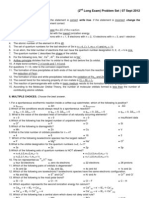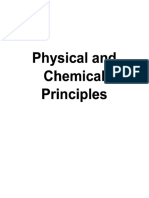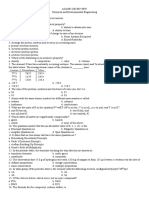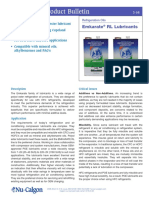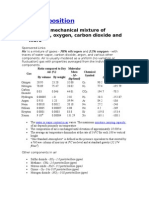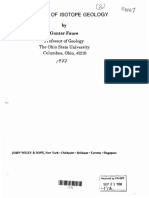0 ratings0% found this document useful (0 votes)
832 viewsGeneral Chemistry Reviewer
General Chemistry Reviewer
Uploaded by
Eugene Concha1. This document contains 40 multiple choice questions about general chemistry concepts. The questions cover topics like chemical processes, physical properties, stoichiometry, atomic structure, bonding, solutions, equilibrium, acid/base reactions and more.
2. The correct answers to each question are provided in letters a-d. Calculating numerical values, identifying concepts, applying formulas and reasoning about chemical phenomena are required to solve the problems.
3. General chemistry foundations like the periodic table, chemical formulas, reaction stoichiometry, states of matter, bonding models, and acid/base chemistry are fundamental to understanding and answering the questions.
Copyright:
© All Rights Reserved
Available Formats
Download as DOCX, PDF, TXT or read online from Scribd
General Chemistry Reviewer
General Chemistry Reviewer
Uploaded by
Eugene Concha0 ratings0% found this document useful (0 votes)
832 views4 pages1. This document contains 40 multiple choice questions about general chemistry concepts. The questions cover topics like chemical processes, physical properties, stoichiometry, atomic structure, bonding, solutions, equilibrium, acid/base reactions and more.
2. The correct answers to each question are provided in letters a-d. Calculating numerical values, identifying concepts, applying formulas and reasoning about chemical phenomena are required to solve the problems.
3. General chemistry foundations like the periodic table, chemical formulas, reaction stoichiometry, states of matter, bonding models, and acid/base chemistry are fundamental to understanding and answering the questions.
Original Description:
reviewer
Copyright
© © All Rights Reserved
Available Formats
DOCX, PDF, TXT or read online from Scribd
Share this document
Did you find this document useful?
Is this content inappropriate?
1. This document contains 40 multiple choice questions about general chemistry concepts. The questions cover topics like chemical processes, physical properties, stoichiometry, atomic structure, bonding, solutions, equilibrium, acid/base reactions and more.
2. The correct answers to each question are provided in letters a-d. Calculating numerical values, identifying concepts, applying formulas and reasoning about chemical phenomena are required to solve the problems.
3. General chemistry foundations like the periodic table, chemical formulas, reaction stoichiometry, states of matter, bonding models, and acid/base chemistry are fundamental to understanding and answering the questions.
Copyright:
© All Rights Reserved
Available Formats
Download as DOCX, PDF, TXT or read online from Scribd
Download as docx, pdf, or txt
0 ratings0% found this document useful (0 votes)
832 views4 pagesGeneral Chemistry Reviewer
General Chemistry Reviewer
Uploaded by
Eugene Concha1. This document contains 40 multiple choice questions about general chemistry concepts. The questions cover topics like chemical processes, physical properties, stoichiometry, atomic structure, bonding, solutions, equilibrium, acid/base reactions and more.
2. The correct answers to each question are provided in letters a-d. Calculating numerical values, identifying concepts, applying formulas and reasoning about chemical phenomena are required to solve the problems.
3. General chemistry foundations like the periodic table, chemical formulas, reaction stoichiometry, states of matter, bonding models, and acid/base chemistry are fundamental to understanding and answering the questions.
Copyright:
© All Rights Reserved
Available Formats
Download as DOCX, PDF, TXT or read online from Scribd
Download as docx, pdf, or txt
You are on page 1of 4
GENERAL CHEMISTRY
1. All of the following are chemical processes except:
a. A liquid vaporizing to form a gas
b. An acid dissolving a metal
c. The rusting of iron
d. The conversion of starch to carbon dioxide and water in an animal
2. Which of the following is not a physical property?
a. Density b. Color c. Boiling point d. Flammability
3. When a 4.9827 g object with a density of 8.8937 g/mL is dropped into a liquid with a
density of 0.7289 g/mL, what mass of liquid will it displace?
a. 0.4084 g b. 4.9827 g c. 0.5602 g d. 0.08196 g
4. What is the percentage by mass of barium in the compound barium hydroxide?
MW: Ba = 137.33 g/mole, O = 16.00 g/mole, H = 1.008 g/mole
a. 33.3% b. 50.0% c. 80.1% d. 88.9%
5. Which of the following is not part of Dalton’s atomic theory?
a. Matter is composed of atoms
b. Atoms are infinitely small
c. Atoms are combined in small whole numbers to form compounds
d. Atoms of different elements are different
6. Calculate the average atomic mass of Ga. Naturally occurring Ga is composed of 60.0%
69
Ga, that has an atomic mass of 68.911, and 40.0% 71Ga, that has an atomic mass of 70.931.
a. 69.72 amu b. 69.92 amu c. 70.00 amu d. 70.12 amu
7. How many sodium atoms would it take to make up a mass of 3.82 x 10-22 g?
a. 1 atom b. 6.022 x 1023 atom c. 100 atoms d. 2.62 x 1020 atoms
8. All of the following are associated with radioactivity except:
a. Beta-particles
b. Fluorescence and phosphorescence
c. Elements of atomic number greater than 83
d. Becquerel and Curie
9. Oxygen and element X react to form a compound that has the formula X5O2 and contains
11.72 g of X per 1.00 g of oxygen. What is the atomic mass of element X in amu?
a. 375 b. 188 c. 75 d. 37.5
10. What is the empirical formula of a compound that contains 53.1% C, 37.2% N, and 9.77%
H by mass? MW: N = 14.01 g/mole, C = 12.01 g/mole
a. 𝐶5 𝑁3 𝐻11 b. 𝐶22 𝑁15 𝐻4 c. 𝐶2 𝑁𝐻4 d. 𝐶10 𝑁6 𝐻22
11. Which of the following cannot be determined from the molecular formula of the compound
C5H10?
a. The molecular mass
b. The mass percent of the compound that is C
c. The mass percent of the compound that is H
d. The density of the compound
12. What is the theoretical yield of sulfur dioxide for the reaction of 10.0 g of oxygen with
sufficient sulfur for a complete reaction? MW: S = 32.06 g/mole
a. 40.0 g b. 30.0 g c. 20.0 g d. 10.0 g
13. Oxygen reacts with nitrogen to form nitrogen dioxide. What is the maximum yield in grams
of nitrogen dioxide that can be obtained if 10.0 g of oxygen and 10.0 g of nitrogen are
reacted?
a. 7.2 g b. 14.4 g c. 16.4 g d. 32.8 g
14. If a 1.000 g mixture of cupric oxide and cuprous oxide is quantitatively reduced to 0.865 g
of Cu, then the mass of cupric oxide in the sample must have been:
a. 0.174 g b. 0.250 g c. 0.258 g d. 0.742 g
15. The density of CO gas at 1.00 atm and 323 K is 1.06 g/L. What is the density of NO gas at
the same temperature and pressure?
a. 0.989 g/L b. 1.06 g/L c. 1.14 g/L d. 22.4 g/L
16. The density of a gas increases when the temperature is increased while holding the pressure
and number of moles to be constant. This statement is a consequence of:
a. Charles’ Law b. Boyle’s Law c. Dalton’s Law d. None of these
17. A gas mixture of nitrogen and carbon dioxide in a volume of 10.0 L has a total pressure of
0.750 atm at a temperature of 273 K. The mixture is known to contain 2.00 g nitrogen.
What is the mass of carbon dioxide in the mixture?
a. 0.2632 g b. 3.12 g c. 11.58 g d. 14.70 g
18. Which of the following is not a form of electromagnetic radiation?
a. Light b. Radiated heat c. Sound d. Microwaves
19. Which of the following has the most energy per photon?
a. X-rays b. Ultraviolet rays c. Visible light d. Infrared radiation
20. How many different states (combinations of l, ml and ms) are possible if n, the major
quantum number is 3?
a. 8 b. 9 c. 18 d. 36
21. How many 3d orbitals are there?
a. 1 b. 5 c. 10 d. 12
22. Following are the three states for fluorine:
1𝑠 2 2𝑠1 2𝑝6 1𝑠 2 2𝑠 2 2𝑝5 1𝑠 2 2𝑠 2 2𝑝4 2𝑑1
They are, respectively:
a. Ground, excited, impossible
b. Ground, impossible, excited
c. Excited, impossible, ground
d. Excited, ground, impossible
23. Which of the following bonds would you expect to be the most polar?
a. N-Bi b. N-Sb c. N-As d. N-P
24. The Lewis structure of NH3 has _____ lone pairs of electrons and _____ double bonds.
a. 2,0 b. 1,0 c. 0,1 d. 0,2
25. Which of the following elements or compound would you expect to have the highest
boiling point?
a. H2 b. F2 c. HF d. HCl
26. All of the following are the result of an electronegativity difference between two atoms
bonded to each other except:
a. Shorter bond length
b. Stronger bond
c. Longer bond length
d. A dipole moment
27. Which of the following elements has the highest ionization energy?
a. Al b. Ga c. Si d. Ge
28. What is the correct order of electronegativities of the elements He, N, O and Ne?
a. He > N > O > Ne
b. He > Ne > O > N
c. Ne > He > N > O
d. He > Ne > N > O
29. The geometry of water and carbon dioxide molecule is/are:
a. See-saw and square pyramidal respectively
b. Both square planar
c. Bent and linear respectively
d. Bothe trigonal planar
30. What is the hybridization of the I atom in IF5?
a. sp2 b. sp3 c. sp3d d. sp3d2
31. Which of the following would you expect to be the stable state of NaH at room temperature?
a. Solid b. Liquid c. Gas d. Plasma
32. Which of the following would you expect to have the highest boiling point?
a. Ne b. Kr c. Xe d. Ar
33. What is the volume of a solution of sucrose, (C12H22O11) in water that contains 123 g of
sucrose and is 0.55 molar?
a. 66 mL b. 220 mL c. 340 mL d. 650 mL
34. What osmotic pressure will be produced if 10 g of sucrose is dissolved in enough water to
produce 400 mL of solution at 298 K?
a. 250 atm b. 1.8 atm c. 0.71 atm d. 0.0060 atm
35. The following reaction is endothermic. What combination of changed conditions would
cause it to proceed more to the right as written?
2𝐶𝑂2(𝑔) → 2𝐶𝑂(𝑔) + 𝑂2(𝑔)
a. Raising the temperature and increasing the pressure
b. Raising the temperature and decreasing the pressure
c. Lowering the temperature and increasing the pressure
d. Lowering the temperature and decreasing the pressure
36. What is the solubility of CaF2 in water in moles of CaF2 per liter of solution? Ksp for CaF2
is 1.7 x 10-10.
a. 9.2 x 10-6 M b. 1.3 x 10-5 M c. 3.5 x 10-4 M d. 5.5 x 10-4 M
37. Addition of which of the following substances to an equilibrium mixture of water and AgCl
will raise the solubility of the AgCl in water?
a. NaCl b. AgNO3 c. AgCl d. None of these
38. What is the concentration of OH- in a water solution of 0.0015 M HCl?
a. 6.7 x 10-12 M b. 1.5 x 1011 M c. 1.5 x 10-3 M d. 6.7 x 102 M
39. What is the pH of a solution of 0.100 M HCN? Ka = 7.2 x 10-10
a. 4.6 b. 5.1 c. 9.1 d. 10.1
40. What is the pH of the resulting solution when 50.0 mL of a 0.10 M HCl solution is added
to 100 mL of a 0.0 M NaOH solution?
a. 14 b. 13 c. 12 d. 11
You might also like
- Physical Chemistry Board Exam Questions PDFDocument10 pagesPhysical Chemistry Board Exam Questions PDFBenedick Jayson P. Marti100% (3)
- Practice Exam I - Organic ChemsitryDocument14 pagesPractice Exam I - Organic ChemsitryDave KowalczykNo ratings yet
- TC LG PDFDocument253 pagesTC LG PDFKieron Ivan M. Gutierrez100% (2)
- NMAT PRACTICE SET 0619 - Rationale - TEST D. ChemistryDocument10 pagesNMAT PRACTICE SET 0619 - Rationale - TEST D. ChemistryMianella RosalesNo ratings yet
- TOS Chem Tech Organic Chemistry Topics CorrespondenceDocument2 pagesTOS Chem Tech Organic Chemistry Topics CorrespondenceRandy Jake Calizo BaluscangNo ratings yet
- ORGANIC CHEMISTRY (Gen-Misc. and Alkanes,-Enes-ynes) (106 Items)Document10 pagesORGANIC CHEMISTRY (Gen-Misc. and Alkanes,-Enes-ynes) (106 Items)Marlon PeterosNo ratings yet
- ChemTech DiagnosticDocument3 pagesChemTech DiagnosticrickiegasparNo ratings yet
- Course Description-ChT 10 Gen Chem FinalDocument3 pagesCourse Description-ChT 10 Gen Chem FinalJoyce EdrozoNo ratings yet
- Chemistry Board ExamDocument6 pagesChemistry Board Examjj01258650% (2)
- Analytical Chemistry Diagnostic With Answer KeyDocument12 pagesAnalytical Chemistry Diagnostic With Answer KeyAnabel AbulenciaNo ratings yet
- Topic Test Oxfordaqa Int A Level Physics Electric Fields and CapacitanceDocument15 pagesTopic Test Oxfordaqa Int A Level Physics Electric Fields and Capacitanceandhi soesiloNo ratings yet
- General Inorganic ChemistryDocument3 pagesGeneral Inorganic ChemistryJomarie Gañalongo100% (1)
- Inorganic Chemistry Competency ExamDocument3 pagesInorganic Chemistry Competency ExamAron Balines50% (2)
- General Chemistry Boards Practice ExamDocument10 pagesGeneral Chemistry Boards Practice ExamKriel MuñezNo ratings yet
- General Chemistry QuestionnaireDocument4 pagesGeneral Chemistry QuestionnaireRugi Vicente RubiNo ratings yet
- Chemistry - Concepts and Multiple ChoiceDocument5 pagesChemistry - Concepts and Multiple ChoiceGeorge Isaac McQuiles100% (1)
- Quantitative Chemistry PS 1 Answers 2022Document3 pagesQuantitative Chemistry PS 1 Answers 2022lyandle minNo ratings yet
- Chem TechDocument181 pagesChem TechDream CakeNo ratings yet
- Set A Cluster 2 Final 08082015Document6 pagesSet A Cluster 2 Final 08082015EJ EsposNo ratings yet
- Quice Review Center: C) The Total Mass of The Atom A) RBDocument5 pagesQuice Review Center: C) The Total Mass of The Atom A) RBMary Francia RicoNo ratings yet
- Analytical Chemistry Problem SetDocument2 pagesAnalytical Chemistry Problem SetElvin Michael Espino100% (2)
- Organic ChemistryDocument13 pagesOrganic ChemistryKuo SarongNo ratings yet
- Physical Chemistry Practice Test 9: (10 Items - 25 Minutes)Document1 pagePhysical Chemistry Practice Test 9: (10 Items - 25 Minutes)Tonton12340% (1)
- Day 1 Analytical Chem ExamDocument20 pagesDay 1 Analytical Chem ExamAnabel Abulencia100% (1)
- ReviewerDocument2 pagesReviewerhoneylet tayactacNo ratings yet
- Analytical ChemistryDocument4 pagesAnalytical ChemistryJewls HatudNo ratings yet
- Analytical ChemistryDocument2 pagesAnalytical ChemistryRochelle Louise SampagaNo ratings yet
- Sampling and Sample Preparation PRoblem SetDocument4 pagesSampling and Sample Preparation PRoblem SetMae Christine PaduaNo ratings yet
- Exam Final Preboard Phy ChemDocument5 pagesExam Final Preboard Phy ChemAira Jean ManingoNo ratings yet
- Malayan Colleges Laguna Mapua Institute of Technology at LagunaDocument18 pagesMalayan Colleges Laguna Mapua Institute of Technology at LagunaAlyssa ApolinarioNo ratings yet
- Organic Chemistry Mock Exam (ANSWER KEY)Document7 pagesOrganic Chemistry Mock Exam (ANSWER KEY)k.talle039100% (1)
- BOARD EXAM GenChem ReviewerDocument46 pagesBOARD EXAM GenChem ReviewerGeraldLouieCorpuzNo ratings yet
- Qdoc - Tips Chemical Engineering ReviewerdocxDocument164 pagesQdoc - Tips Chemical Engineering Reviewerdocxengr c10h15nNo ratings yet
- TOS Chem Tech-Analytical Chemistry TopicsDocument2 pagesTOS Chem Tech-Analytical Chemistry TopicsApril Joyce RaymundoNo ratings yet
- Revised Ana ChemDocument32 pagesRevised Ana ChemMeggy Arao50% (2)
- Genchem Tamu II (102 Items)Document10 pagesGenchem Tamu II (102 Items)Mark Ryan TripoleNo ratings yet
- ReviewerDocument6 pagesReviewerMariAntonetteChangNo ratings yet
- Analytical Chemistry - Multiple Choice - UkraineDocument23 pagesAnalytical Chemistry - Multiple Choice - UkrainethucinorNo ratings yet
- 2023 - Analytical Chemistry With Answers 1Document14 pages2023 - Analytical Chemistry With Answers 1sbelodoNo ratings yet
- Analytical Chemistry CH 342 20132Document1 pageAnalytical Chemistry CH 342 20132KaizerNo ratings yet
- Organic Chemistry 2023 QuestionnaireDocument3 pagesOrganic Chemistry 2023 QuestionnaireJD6 Agarb100% (2)
- My FilesDocument18 pagesMy Filesjake dionisioNo ratings yet
- Ana Phy Org Chem CompilationDocument17 pagesAna Phy Org Chem CompilationNikki Ebañez100% (1)
- Acids and BasesDocument3 pagesAcids and BasesJoseph FruitNo ratings yet
- Ana ChemDocument14 pagesAna ChemSamuel MagannonNo ratings yet
- Analytical Chemistry 20132Document1 pageAnalytical Chemistry 20132zzrot1No ratings yet
- MCQs On Introduction To Analytical Chemistry With Answer PDF - YB StudyDocument8 pagesMCQs On Introduction To Analytical Chemistry With Answer PDF - YB Studypranab duttaNo ratings yet
- Multiple Choice: TrueorfalseDocument4 pagesMultiple Choice: TrueorfalseMary Francia Rico100% (1)
- Study Guide Chemical Technician: TEST #2782Document7 pagesStudy Guide Chemical Technician: TEST #2782orly shellNo ratings yet
- Chemistry ReviewerDocument3 pagesChemistry ReviewerKiki_Amamanglon_3115No ratings yet
- Day 1 - MockboardsDocument12 pagesDay 1 - MockboardsKhiara Claudine Espinosa100% (1)
- Tos For Analytical ChemistryDocument3 pagesTos For Analytical ChemistryMary Francia RicoNo ratings yet
- Chem DiagnosticDocument3 pagesChem DiagnosticHeather Nicole BelinoNo ratings yet
- Chem 132 2019 Tutorial QuestionsDocument3 pagesChem 132 2019 Tutorial QuestionsYusuf Zaynab100% (1)
- Chemistry GRE SampleDocument0 pagesChemistry GRE Sampleyoostan100% (2)
- Analytical ChemDocument2 pagesAnalytical ChemVaanNo ratings yet
- ChE Board Exam May 2016Document14 pagesChE Board Exam May 2016Hannah Pascua100% (1)
- Finals Chem 21Document6 pagesFinals Chem 21Adrian NavarraNo ratings yet
- HopeyDocument6 pagesHopeyzaneNo ratings yet
- Chemistry and Envi EnggDocument7 pagesChemistry and Envi EnggSheryll PascobilloNo ratings yet
- chemistry cetsDocument8 pageschemistry cetsvanessasegarra37No ratings yet
- Gas Power Cycles The Carnot Gas Power CycleDocument6 pagesGas Power Cycles The Carnot Gas Power CycleAdnan Shahariar AnikNo ratings yet
- Development of Low Particle Emission Brake RotorsDocument162 pagesDevelopment of Low Particle Emission Brake RotorsAlemayehu MideksaNo ratings yet
- Non-Varnishing PAG-based Turbine Fluid and GEKDocument25 pagesNon-Varnishing PAG-based Turbine Fluid and GEKElwanNo ratings yet
- Aceites para Refrigeracion EmkarateDocument4 pagesAceites para Refrigeracion EmkarateLu KaNo ratings yet
- Degradation of Sunset Yellow FCF Using Copper Loaded Be - 2017 - Arabian JournalDocument7 pagesDegradation of Sunset Yellow FCF Using Copper Loaded Be - 2017 - Arabian Journallucian_lovNo ratings yet
- Ahmedabad, Gujarat, India.: Cell No.+91 9898231676Document55 pagesAhmedabad, Gujarat, India.: Cell No.+91 9898231676valiuddinNo ratings yet
- SAE 8620H Chemical Composition, SAE 8620H Mechanical Properties, SAE 8620H Heat TreatmentDocument2 pagesSAE 8620H Chemical Composition, SAE 8620H Mechanical Properties, SAE 8620H Heat TreatmentAnush Swaminathan100% (1)
- 3.4.2.2 The Young ModulusDocument83 pages3.4.2.2 The Young ModulusThushani KirupaharanNo ratings yet
- Classical GasesDocument30 pagesClassical GasesingarionNo ratings yet
- Project Report FinalDocument115 pagesProject Report FinalJhomar HernandezNo ratings yet
- Dynamics Tutorial Sheet 5 - Rigid Body KineticsDocument4 pagesDynamics Tutorial Sheet 5 - Rigid Body KineticsmahirNo ratings yet
- Deflection Limits For CraneDocument6 pagesDeflection Limits For CraneThanh Dao BaNo ratings yet
- Heat Exchanger Aftercooler and SeparatorDocument16 pagesHeat Exchanger Aftercooler and Separatorjaskaran singhNo ratings yet
- Fluid Flow and MixingDocument19 pagesFluid Flow and MixingvikichopdaNo ratings yet
- Spec I Task 4 Classification of MatterDocument11 pagesSpec I Task 4 Classification of MatterJERIEL MARTIREZNo ratings yet
- Air CompositionDocument2 pagesAir CompositionHarsh Vardhan SharmaNo ratings yet
- Bscpe Sci1 SLM 5Document25 pagesBscpe Sci1 SLM 5April Joy GonzalesNo ratings yet
- Shoring CalculationDocument7 pagesShoring CalculationNicky198No ratings yet
- Isotropic Reconstruction of 3D Fluorescence Microscopy Images Using Convolutional Neural NetworksDocument9 pagesIsotropic Reconstruction of 3D Fluorescence Microscopy Images Using Convolutional Neural NetworksAdrian ShajkofciNo ratings yet
- Dynamic Scattering Function For High-Temperature Liquid LeadDocument8 pagesDynamic Scattering Function For High-Temperature Liquid LeadMatija KorvinNo ratings yet
- $DC Circuit Ocr Paper 2Document50 pages$DC Circuit Ocr Paper 2ALI ASHRAFNo ratings yet
- Colpoly 7167 TDSDocument2 pagesColpoly 7167 TDSKristjan PosavecNo ratings yet
- Why Do We Need A ParliamentDocument11 pagesWhy Do We Need A ParliamentMohan LalNo ratings yet
- Aluminum A380Document4 pagesAluminum A380syuepiNo ratings yet
- Principles of Isotope GeologyDocument2 pagesPrinciples of Isotope GeologySaikat AdhikaryNo ratings yet
- Site-Specific Ground Response AnalysisDocument9 pagesSite-Specific Ground Response AnalysisAugustato D'AravelaNo ratings yet
- XE7000液压挖掘机技术规格书(正铲)Document29 pagesXE7000液压挖掘机技术规格书(正铲)abang100% (1)
- Calculation and Analysis of Critical Heat Flux atDocument16 pagesCalculation and Analysis of Critical Heat Flux atAmairani Fuentes AndradeNo ratings yet
- Iodine PartitionDocument3 pagesIodine PartitionyukiNo ratings yet




















